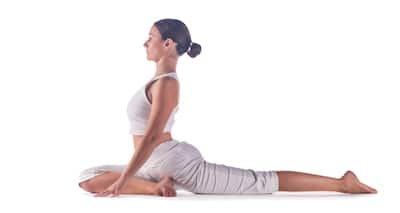
One of the simplest ways to approach the Pigeon Pose is from a Downward Facing Dog.
Kapotasana -Pigeon Pose: The pigeon pose, or yoga pose, is another name for Kapotasana. Kapota and Asana both translate to pigeon or dove in Sanskrit. Kapotasana helps your body meditate more readily by opening your hip joints. This yoga pose falls under the intermediate to advanced category. Some antecedent postures for kapotasana are seated forward bend, cradle, and butterfly pose. There are four varieties of the pigeon stance or pigeon stretch:
- The pigeon pose
- The resting pigeon pose
- The one-legged king pigeon pose
- The king pigeon pose
In the case of asthma, kapotasana could be helpful. It could aid in increasing muscular flexibility. Kapotasana may assist with stress and weight management. Back discomfort and mental health may benefit from it.
Step-by-Step Instructions By Himalayan Siddhaa Akshar, Yoga and Spiritual Leader, Founder Of Akshar Yoga Institutions
One of the simplest ways to approach the Pigeon Pose is from a Downward Facing Dog:
READ RELATED: 10 Best Supplements You Should Be Taking After 40

- Raise the right leg from Downward Dog.
- Extend your right leg, bend it, and place it on the ground before your right hand.
- Keep your left leg level on the floor and place your left knee on your mat.
- Make sure your left foot is straight behind you.
- Square your hips in the direction of the mat’s front.
- To make the position more comfortable, use a cushion or a folded blanket as needed and lay it under your right hip.
- Once you feel secure, lean forward over your right leg with your body.
- Maintain a square hip position and distribute your weight equally on both sides.
Pose Benefits:
- Stretches the thighs, groin, back, piriformis, and psoas muscles to loosen up stiff hips.
- Increases the femur’s external rotation in the hip socket and lengthens the hip flexors, increasing hip flexibility.
- Stretches the knee-area muscles, tendons, and ligaments while boosting circulation there.
- Enhances breathing and posture
- Reduces back discomfort
- It brings the attention inward, soothing the mind
- It opens the shoulder joints and cervical area
- Relieves stored stress in the area of the neck
- Stimulates the thymus gland, which enhances immunological performance
- It helps treat piles, colitis, and sciatica
Contraindications
For those who have recently had knee replacement surgery, spinal, abdominal, or sacral injuries, sacroiliac difficulties, hip injuries, or have just undergone hip replacement surgery, this posture should be avoided. Additionally, people with weak or rigid wrists should exercise caution.
- Avoid this pose if you have a hip problem.
- Avoid or leave the pose if you feel any stress on the knee.
Total Wellness is now just a click away.
Follow us on
Don’t Miss Out on the Latest Updates.
Subscribe to Our Newsletter Today!
window.addEventListener(‘load’, (event) => {
$(‘#commentbtn’).on(“click”,function(){
(function(d, s, id) { var js, fjs = d.getElementsByTagName(s)[0]; if (d.getElementById(id)) return; js = d.createElement(s); js.id = id; js.src = “//connect.facebook.net/en_US/sdk.js#xfbml=1&version=v2.3”; fjs.parentNode.insertBefore(js, fjs);}(document, ‘script’, ‘facebook-jssdk’));
$(“.cmntbox”).toggle();
});
});







